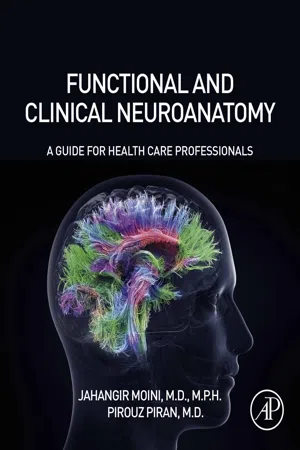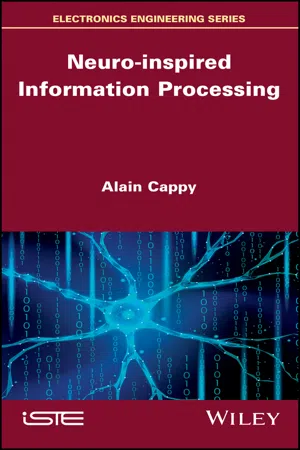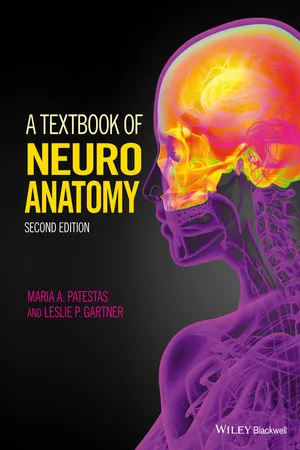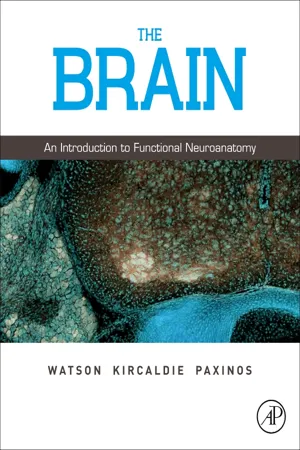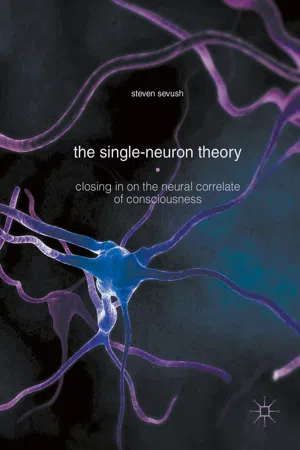Psychology
The Cerebral Cortex
The cerebral cortex is the outer layer of the brain responsible for higher cognitive functions such as thinking, perceiving, and decision-making. It is divided into four lobes—frontal, parietal, temporal, and occipital—each with specific roles in processing sensory information and controlling motor functions. The cerebral cortex plays a crucial role in human behavior, personality, and consciousness.
Written by Perlego with AI-assistance
Related key terms
Related key terms
1 of 4
Related key terms
1 of 3
9 Key excerpts on "The Cerebral Cortex"
- eBook - ePub
Functional and Clinical Neuroanatomy
A Guide for Health Care Professionals
- Jahangir Moini, Pirouz Piran(Authors)
- 2020(Publication Date)
- Academic Press(Publisher)
Chapter 6Cerebral cortex
Abstract
The Cerebral Cortex is a layer of neurons and synapses (gray matter) on the surface of the cerebral hemispheres. This is folded into gyri, and about two-thirds of the cortex's area is buried inside fissures. The Cerebral Cortex integrates higher mental functions, general movements, functions of the viscera, perceptions, and behavioral reactions. It has many different classifications. The Cerebral Cortex has 47 separate function areas, with differing cellular designs.Keywords
Cerebrum; Gross anatomy; Cerebral cortex; Neocortex; Electroencephalogram; Split-brain syndromeThe Cerebral Cortex is a layer of neurons and synapses (gray matter) on the surface of the cerebral hemispheres. This is folded into gyri, and about two-thirds of the cortex's area is buried inside fissures. The Cerebral Cortex integrates higher mental functions, general movements, functions of the viscera, perceptions, and behavioral reactions. It has many different classifications. The Cerebral Cortex has 47 separate function areas, with differing cellular designs.Stimulation of the precentral cortex or motor area, using electrodes, causes contractions of the voluntary muscles. If the motor speech area in the inferior frontal gyrus is destroyed, this causes motor aphasia or speech defects, even though the vocal organs are healthy and intact. If the brain cortex is stimulated as in case of a seizure, this stimulation will affect circulation, respiration, reactions of the pupils, and other visceral activities.Cerebrum
The cerebrum is the largest and most obvious portion of the human brain. It forms from the embryonic structure called the telencephalon . The cerebrum is the center of voluntary motor control and complex mental processes.Gross anatomy
The cerebrum is much larger than the other portions of the brain. It is divided into two cerebral hemispheres that are separated by the longitudinal fissure . A prominent tract of fibers called the corpus callosum also connects the hemispheres. Each hemisphere has conspicuous gyri , which appear as “wrinkles” that are separated by grooves known as sulci . The surface of the cerebrum folds into the gyri in a way that allows for a larger amount of cortex to fit inside the cranium and because of the gyri, the cerebrum has about 2500 cm2 - eBook - ePub
- Mark J. Cain(Author)
- 2015(Publication Date)
- Polity(Publisher)
First, each distinctive structure in the brain constantly interacts with other structures in doing what it does. Second, each structure can play a role in supporting what from the commonsense perspective are quite different cognitive and behavioural capacities. And, third, the exercise of most such capacities will involve the operation of more than one structure. The Cerebral Cortex is divided into four areas or lobes, each with the following rough functions. The frontal lobes run from the front of the brain to a deep groove known as the central sulcus located half-way along the top of the brain. Its primary function relates to motor behaviour – that is, to planning what actions to carry out and generating the instructions that initiate those actions. Different areas of the frontal lobe make their own specific contribution to this general motor theme. The area at the very front of the frontal lobe (the most ‘anterior’ area in neuroscience speak) is concerned with the most abstract aspects of planning. An example would be the process of your deciding to stop reading shortly and go and make a cup of coffee. The prefrontal lobe takes up most of the frontal lobe and is far more developed in humans than in any other species, explaining our peerless capacity to plan and engage in flexible behaviour. At the rear (or posterior) part of the frontal lobe is a strip known as the primary motor cortex. It generates the specific instructions that are sent directly to motor neurons which, in turn, connect to the muscles controlling bodily movement. It would thus be involved in causing the specific bodily movements that you carried out when you made that cup of coffee. One very interesting feature of the primary motor cortex is that it encodes what is known as a motor map. That is, specific parts of the primary motor cortex correspond directly to specific parts of the body in the respect that their activation causes movement of that body part - eBook - ePub
- Alain Cappy(Author)
- 2020(Publication Date)
- Wiley-ISTE(Publisher)
- – The Cerebral Cortex, or gray matter, constitutes the outer layer of the brain, a layer that contains a large proportion of neurons. It is subdivided into several lobes, defined according to their location: the frontal lobe (motor skills, memory and reasoning), the parietal lobe (touch), the temporal lobe (hearing and smell) and the occipital lobe (vision);
- – the thalamus, which mainly acts as a relay and integrator of afferent sensory and sensorial information and efferent motor information;
- – the hypothalamus, which is involved in regulating major functions such as hunger, thirst, sleep and body temperature;
- – the pituitary gland, which produces hormones;
- – the hippocampus (not visible on the cross section presented in Figure 2.1 ), which is involved in attention, spatial memory and navigation;
- – the cerebellum, which manages motor coordination and learning of routine movements;
- – the brain stem, which forms the link between the brain and the spinal cord. It controls reflex and vegetative movements: breathing, moderation of heart rate, etc.
The lobes of the left hemisphere and cross-sectional view of the brain. For a color version of this figure, see www.iste.co.uk/cappy/neuro.zipFigure 2.1.All of these parts of the brain result from the evolution of living beings and are found, though only in part, throughout the animal kingdom. As our goal is not to copy the living, but to draw inspiration from it to design new information processing systems, our task is to extract the essential aspects. We can expect this process to be complicated with such a complex organ. Fortunately, one part of the brain in particular, the cortex, appears today as the heart of information processing, and we will use this as our main point of focus.2.2. Cortex
2.2.1. StructureThe Cerebral Cortex is the outer layer of the brain, comprising approximately 16 billion neurons1 , hence it being known as the gray matter. The cortex is highly developed in mammals, and particularly so in human beings2 , but is not to be found in birds or reptiles3 .The cortex is only 2–3 mm thick, depending on the location. It is folded in on itself multiple times in order to fit inside the skull, with its total surface area occupying approximately 2,500 cm2 - eBook - ePub
- Maria A. Patestas, Leslie P. Gartner(Authors)
- 2016(Publication Date)
- Wiley-Blackwell(Publisher)
A 45-year-old woman, who was previously in perfect health, had two seizures in the past week. Both occurred suddenly and each lasted less than a minute. The first seizure started as twitching of the right side of the face, which progressed to twitching of her right hand and then her right leg. She felt some perioral numbness as well. There was no loss of consciousness or other symptoms, and she was aware of what had occurred. This happened while in bed. The second seizure, as described by her husband, started with facial twitching but she rapidly lost consciousness and then had a generalized convulsion. She bit her tongue and had blood in her mouth. She also had urinary incontinence. She began responding a few minutes after the convulsion, but she was still confused and somewhat agitated for about 30 minutes after that. She had never had a seizure before. In between these spells she had been normal and examination was normal.The cerebral cortex is the most complex component of the human brain, as a result of its complex and widespread connections. It functions in the planning and initiation of motor activity, perception and conscious awareness of sensory information, learning, cognition, comprehension, memory, conceptual thinking, and awareness of emotions.The Cerebral Cortex (L., cortex, “bark”) is a multilayered sheet of nerve cell bodies and associated cell processes that covers the paired and prominent cerebral hemispheres of the cerebrum, forming a superficial layer much like bark covers a tree. The majority of The Cerebral Cortex consists of phylogenetically the most highly evolved and complex neural tissue of the human brain.The central nervous system (CNS) is comprised of white and gray matter. White matter consists mostly of nerve cell axons, whereas gray matter consists mostly of nerve cell bodies. Gray matter is arranged into nuclei or cortex. Nuclei are aggregations of nerve cell bodies embedded deep within the cerebrum or in the spinal cord. The cerebral cortex consists of 50–100 billion nerve cell bodies arranged into a three- to six-layered sheet that laminates the brain surface.The Cerebral Cortex overlies the subcortical white matter of the cerebral hemispheres. In other animals, the brain's cortical surface appears smooth, whereas in humans the brain surface is convoluted displaying prominent, alternating grooves and elevations as a result of the folding of The Cerebral Cortex, which occurs during development. The elevations are referred to as gyri, whereas the grooves are referred to as sulci or fissures (Fig. 25.1 ). Sulci are shallow, short grooves, whereas fissures are deeper and more constant grooves, with a consistent location on the brain surface. The cortex forming the gyri dips down into the pit of the adjacent sulci or fissures to line them. Certain gyri, sulci, and fissures are similar in all normal human brains. Others, however, may vary in different brains and in the two cerebral hemispheres of the same brain. The gyri and sulci greatly increase the total surface area of The Cerebral Cortex. If The Cerebral Cortex of a normal human brain were spread out (that is, if the pleats formed by the sulci and fissures were stretched out), the cortex would extend over 0.23 m2 (2.5 ft2 - eBook - ePub
The Brain
An Introduction to Functional Neuroanatomy
- Charles Watson, Matthew Kirkcaldie, George Paxinos(Authors)
- 2010(Publication Date)
- Academic Press(Publisher)
These highly sophisticated areas, termed cortical association areas, make up the bulk of the human neocortex. Some clues to the function of the association areas are offered by the study of some people with cortical damage. These people may lose the ability to combine certain types of information, such as the ability to name objects or read maps, or they may have larger deficits such as a complete loss of color perception. In prefrontal regions, the result of damage may be subtle, such as small deficits in planning, organization, and concern for the future. There may also be inappropriate behavior in social settings. These types of deficits have taught neuroscientists and neuropsychologists a great deal about the processing abilities of the cortex, but we still lack any real understanding of how these abilities are generated.The Cerebral Cortex and behaviorMuch of the survival behavior in mammals does not primarily involve The Cerebral Cortex. Most basic behaviors and many learned movements take place with minimal cortical input. This is evident in experiments in which rats have had their cortex removed; the rats are still able to feed, drink, and avoid threats.However, damage to some cortical areas in humans can produce subtle but profound personality changes and behavioral problems. In the past it was popular to talk about ‘silent’ areas of cortex but it is now apparent that the function of these areas is simply too sophisticated to be measured in standard clinical situations. The Cerebral Cortex is extremely expensive to run in terms of metabolic energy, and its cells are in near-constant activity during awake behavior. Any animal with silent cortical regions would simply be wasting energy, endangering its survival.The main job of The Cerebral Cortex is to analyze, predict, and respond to environmental events.Alexander Luria and aphasiaThe brilliant Russian researcher Alexander Luria is credited with inventing the field of neuropsychology. During the Second World War he made a detailed study of the abilities of soldiers who had suffered small head injuries. His analysis is the foundation of modern theories on aphasia (the inability to communicate). The introduction of Armalite-style weaponry in recent years means that small wartime head injuries are now extremely rare, because a modern bullet flattens on impact to make much larger wounds. Because of cold-war politics, American scientists largely ignored Luria's extraordinary work until the 1970s. - Randy W. Beck(Author)
- 2011(Publication Date)
- Churchill Livingstone(Publisher)
The cortex in humans is composed of several well-identified functional areas, interspersed in the cortical matter referred to as association cortex. Although we will speak of functional localisation of a variety of areas of cortex, in reality the functional systems of the neuraxis work in conjunction with each other to produce the best possible outcome for the circumstances at hand. For example, the thought processes attributed to the frontal cortex need to interact with the basal ganglion in order to flow and unfold in a meaningful way. The hippocampus and amygdala are essential functional areas for the fusion of emotions and behavioural response which are attributed to cortical functions. Movement, controlled by the motor cortex in the frontal lobe, is meaningless and random without the feedback supplied by the spinal cord and cerebellum. The cortex can be divided into the lobar areas, as outlined below.Quick facts 9.6Layers of cerebral cortex- • It is convenient for learning purposes to divide The Cerebral Cortex into layers that may be distinguished by cell types, cell functions, cell density, and cell arrangements.
- • These layers include six levels of cortex (layers I–VI) also named from superficial to deep:
- • Molecular layer (plexiform layer)
- • External granular layer
- • External pyramidal layer
- • Internal granular layer
- • Ganglionic layer (internal pyramidal layer)
- • Multiform layer (layer of polymorphic cells)
Quick facts 9.7Types of cells in the cortex- • Martinotti cells
- • Neurogliaform
- • Basket cells
- • Horizontal cells
- • Fusiform cells
- • Stellate cells
- • Pyramidal cells
The frontal lobes
The frontal lobe is concerned with sophisticated operations such as higher-order sensory processing, planning, implementation, language processing, abstract thought, and regulation of movement, cognition, emotion, and behaviour. The most anterior part of the frontal lobe is involved in complex cognitive processes such as reasoning and judgement. Collectively, these processes may be called biological intelligence . A component of biological intelligence is executive function- eBook - ePub
- Todd W. Vanderah, Douglas J. Gould(Authors)
- 2020(Publication Date)
- Elsevier(Publisher)
Fig. 22.1 ).Fig. 22.1Major gyri of a human cerebral hemisphere. O, Or, T, Opercular, orbital, and triangular parts of the inferior frontal gyrus; SPL, superior parietal lobule.One of the more striking changes that has occurred in the course of the evolution of vertebrate brains is the tremendous increase in the relative size of the cerebral hemispheres and the even greater increase in the area of cerebral cortex on their surfaces. One inference drawn from this fact (and supported by abundant clinical and functional imaging evidence) is that The Cerebral Cortex has a critical role in the abilities and activities that reach their highest level of development in humans (or, in some cases, are unique to humans). Obvious examples are language and abstract thinking. These are, of course, not the only functions of The Cerebral Cortex; basic aspects of perception, movement, and adaptive response to the outside world also depend on it.Most Cerebral Cortex Is Neocortex
Cerebral cortex does not have the same structure everywhere. Almost all of the cortex that can be seen on the outside of the brain is of a type called neocortex, neo- referring to the idea that it appeared fairly late in vertebrate evolution. Reptiles have cerebral cortex, but all of it consists of three-layered types that continue in humans as paleocortex (paleo = “old”) and archicortex (archi = “beginning”), named in reference to their supposedly more ancient origins.a Paleocortex covers some restricted parts of the base of the telencephalon (Fig. 22.2 ), and most of the hippocampus is archicortex. Neocortex has a different structure, described shortly, and develops interposed between the paleocortex and archicortex, separated from them by cortical transition zones with intermediate structures. Some mammals have relatively little neocortex, but it expands greatly in primates, accounting for about 95% of the total cortical area in humans. This expansion causes the apparent rotation of the cerebral hemispheres into their characteristic C shape, with paleocortex and archicortex at the two ends of the C (see Fig. 2.12 - eBook - ePub
The Single-Neuron Theory
Closing in on the Neural Correlate of Consciousness
- Steven Sevush(Author)
- 2016(Publication Date)
- Palgrave Macmillan(Publisher)
Components of the central nervous systemThe Cerebral Cortex is the thin (~4 mm thick) outer covering of the cerebrum. It is composed of gray matter, which is brain tissue containing nerve cell bodies and short-range connecting fibers. The cortical sheet is extensively folded into alternating furrows (sulci) and ridges (gyri) that give the cortex its characteristic corrugated appearance and that serve to increase its surface area, thereby increasing the number of neurons it can contain. Deep to The Cerebral Cortex is white matter, which consists of long range connecting fibers.The Cerebral Cortex will command much of our attention as we search for the NCC. The Cerebral Cortex is responsible for higher cognitive functions such as memory, language, perception, reasoning, and the execution of complex motor tasks, and its destruction leaves one in a vegetative state. It is The Cerebral Cortex that has been proposed as the site of the NCC in most contemporary mind/brain theories.The connection between The Cerebral Cortex, or the brain more generally, and conscious experience has not always been evident. For thousands of years the ancient Egyptians, like others before them, linked the mind with the body as a whole rather than with any particular organ. They believed that the spiritual “Ka,” which they held was the repository for memory and personality, was a “body double” that assumed the shape of the whole person. As for the brain, the ancient Egyptians thought so little of it that they routinely scooped it out through the nose and discarded it ignominiously when preparing mummies for the afterlife.It wasn’t until the ascendance of the Greeks, and most notably Hippocrates of Eos (of “Hippocratic Oath” fame), that a mind/brain connection was first proposed. In the early fifth century BC Hippocrates perceptively wrote:One ought to know that on the one hand pleasure, joy, laughter, and games, and on the other, grief, sorrow, discontent, and dissatisfaction arise only from the brain. It is especially by it that we think, comprehend, see, and hear, that we distinguish the ugly from the beautiful, the bad from the good, the agreeable from the disagreeable. - eBook - ePub
Vision Facts
Questions about the Human Eye
- Jason Yang, Pidgeon Charles(Authors)
- 2018(Publication Date)
- Universal-Publishers(Publisher)
great-grandmother cell hypothesis is a name for an early attempt to explain how the brain processes visual information. In this hypothesis, there is a neuron in the brain for every object that can be recognized, including one for your great-grandmother. However, this hypothesis has been refuted, as a neuron for every recognizable object means that the brain would have to be far larger than is realistic.Gross, C. G. “Genealogy of the ‘grandmother cell.’” Neuroscientist 8, no. 5 (October 2002): 512–18. Accessed September 21, 2017. https://www.ncbi.nlm.nih.gov/pubmed/12374433 .Q97 What is The Cerebral Cortex? A97 The cerebral cortex (or “cortex”) is a layer of neurons two to four millimeters thick on the surface of the brain. It is composed closely packed neurons forming gray matter. The Cerebral Cortex consists of four lobes: the occipital, parietal, temporal, and frontal lobes. It is divided into the left and right cerebral hemispheres.Some main functions of The Cerebral Cortex include perception, awareness, memory, consciousness, speech, and higher level thinking.“The Cerebral Cortex.” AP Psychology Community . Accessed September 14, 2017. http://www.appsychology.com/Book/Biological/cerebral_cortex.htm .The Cerebral Cortex consists of four lobes: the frontal lobe (red), parietal lobe (green), temporal lobe (blue), and occipital lobe (yellow).Q98 What is the function of each lobe of the cortex? A98 Each lobe in the cortex serves unique roles. The frontal lobe is considered to be the control center for emotions and personality. It is also involved in problem solving, motor skills, judgement, and social behaviour. The parietal lobe processes information related to several senses, including taste, temperature, touch, as well as helping out with vision. The temporal lobe is primarily involved in hearing and language. However, parts of the temporal lobe are also dedicated to vision. Finally, the occipital lobe
Index pages curate the most relevant extracts from our library of academic textbooks. They’ve been created using an in-house natural language model (NLM), each adding context and meaning to key research topics.
Explore more topic indexes
Explore more topic indexes
1 of 6
Explore more topic indexes
1 of 4
